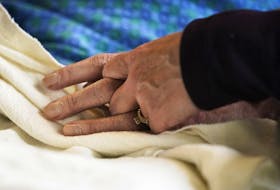A study of the first 41 lab-confirmed cases of the Wuhan coronavirus that has quarantined millions in China reveals a worrying “severity” of illness, with almost a third developing acute respiratory distress syndrome requiring intensive care.
The infection caused clusters of fatal pneumonia with symptoms resembling, but also different from SARS. Of the 41 cases, six people died, five developed acute cardiac injury and four required mechanical ventilation, according to a study released Friday by the prestigious journal, The Lancet .
“The pieces of the puzzle that is 2019-nCOV are only now beginning to come together,” reads an accompanying editorial .
The study was one of a flurry of papers released by the journal Friday. A second study by Chinese scientists involved a family of six from Guangdong province, a coastal area bordering Hong Kong, who visited Wuhan, ground zero of the outbreak, in late December and early January. Five became infected, as well as another family member who didn’t travel to Wuhan, providing what scientists believe is the first published evidence of human-to-human transmission. Another child, a 10-year-old, was infected, but showed no symptoms.
Together the studies reveal a disease with a three to six day incubation period and “insidious” onset of fever, cough and muscle pain, Dr. David Heymann, of the London School of Hygiene & Tropical Medicine writes in The Lancet. While some had mild disease, older people developed severe infections needing intubation and intensive care.
On Thursday, the World Health Organization said that while the rogue virus is an emergency in China, “it has not yet become a global health emergency,” said director general Dr. Tedros Adhanom Ghebreyesus. More than 835 cases have been confirmed in China, 25 of them fatal, since the first alert was issued just before midnight on Dec. 30 of four unexplained cases of pneumonia in Wuhan linked to a seafood market that was also selling freshly slaughtered game animals.
Twenty-seven of the first 41 lab-confirmed cases all had direct exposure to the market, and all developed viral pneumonia, the Lancet reports. The cases occurred between Dec. 16 and Jan. 2.
The infected were, on average, otherwise previously healthy middle-aged people (average age 49) most had visited the Huanan seafood market and most (73 per cent) were male.
All of those admitted to hospital had pneumonia, and most had fever, cough and fatigue. Over half also experienced shortness of breath.
However, unlike SARS, symptoms such as runny nose, sneezing, sore throat, and intestinal symptoms like diarrhea were uncommon.
The source of the infection remains unknown, however the virus, like SARS, is most closely related to coronaviruses from Chinese horseshoe bats.
The death rate also isn’t clear because the true number of infections is unknown, not all the people have recovered or died and, in emerging infections like this, the case-fatality ratio is often overestimated in the early stages because it tends to focus on only the most severely ill. Based on the more than 800 cases reported in China as of Jan. 24, the overall death rate appears to be hovering around three percent.
“There are still many gaps in our understanding,” The Lancet editorial reads. Importantly, “the exposure and possible infection of health workers remain extremely worrying.”
None of the family members in the second study had visited Wuhan markets or had contact with live animals, however two had visited a relative in a Wuhan hospital. Five developed symptoms such as fever, upper or lower respiratory tract symptoms and diarrhea. Only one child who wore a surgical mask for most of the stay in Wuhan wasn’t infected. The 10-year-old who didn’t have symptoms showed the same patchy, “ground glass” shadows in her lungs as her sick relatives on CT scans, meaning people may be able to spread infections without knowing they are infected.
That makes it more crucial to isolate the infected and trace and quarantine contacts as quickly as possible, said lead researcher Kwok-Yung Yeun from the University of Hong Kong-Shenzhen Hospital.
Sixteen health-care workers, some of who were working in the same wards as the infected contracted the virus. However, it’s not yet clear whether there exist “super-spreaders,” people capable of shedding large amounts of virus, as was the case with SARS, the researchers said.
The studies are early and involve only small clusters of patients. But one important difference between the Wuhan virus and SARS is that most people don’t have symptoms such as a runny nose or sneezing. “Sneezes and runny noses are a prime way for people to spread infections,” meaning the new virus might not be so easily spread, said Paul Hunter, professor of medicine at Norwich Medical School.
But if people might be harbouring the virus without knowing it, “really tracking and containing this thing could be very difficult, because lots of people are capable of spreading it even if they don’t have symptoms themselves,” said Matthew Miller, an associate professor in the Michael G. DeGroote Institute for Infectious Diseases Research at McMaster University in Hamilton.
The next one to two weeks “will tell the tale of whether this becomes a real global problem or stays mostly geographically isolated,” Miller said.
The fact that it can cause severe disease in otherwise healthy people is something we should watch, he said. However, a three per cent death rate would put it more in line with a seasonal flu, which causes hundreds of millions of infections globally every year.
Although the sequencing data says it came from bats, “it’s unlikely people were slaughtering bats,” Miller said. “It probably went from bats into some other game species that was being sold at that market.”
The decision by Chinese officials to quarantine millions with sweeping travel restrictions and closing off public transit was a bold move, he added. However, we have no vaccines and we really don’t have any anti-viral drugs for coronavirus. “Our only way of controlling this thing is through prevention of transmission or isolation/quarantine type efforts.” But it could get dangerous if people can’t get access to basic services like food or medicines, he said.
POPULAR ON NP RIGHT NOW
Raymond de Souza: Auschwitz and Russia’s selective memory of the Second World War
Braid: Conservative field shrinks as Harper talk starts
Apocalyptic scenes engulf Chinese cities as lockdown expands to include 40 million people
Copyright Postmedia Network Inc., 2020








